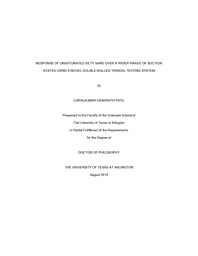
ATTENTION: The works hosted here are being migrated to a new repository that will consolidate resources, improve discoverability, and better show UTA's research impact on the global community. We will update authors as the migration progresses. Please see MavMatrix for more information.
Show simple item record
| dc.contributor.author | Patil, Ujwalkumar Dashrath | en_US |
| dc.date.accessioned | 2014-09-17T17:30:25Z | |
| dc.date.available | 2014-09-17T17:30:25Z | |
| dc.date.issued | 2014-09-17 | |
| dc.date.submitted | January 2014 | en_US |
| dc.identifier.other | DISS-12791 | en_US |
| dc.identifier.uri | http://hdl.handle.net/10106/24761 | |
| dc.description.abstract | In recent decades, the state-of-the-art of our understanding of unsaturated soil performance has been considerably enhanced by incorporating novel and advanced features to the conventional testing devices such as direct shear device, ring shear device, triaxial device and true triaxial device. The novel suction-controlled triaxial system used in this research is fully automated and has enhanced features such as volume change device and double-walled cell to monitor the volume change accurately during all the stages of unsaturated triaxial test. Despite the sophistication, such devices can help in testing mechanical behavior of unsaturated soils only up to matric suction (s) value of 1500 kPa (limitation in using axis-translation technique to control matric suction). There is a limited experimental evidence of unsaturated soil response over a wider range of suction. This research takes motivation from such needs of investigating the influence of a wide range of soil suction on the shear strength as well as volume change behavior of compacted silty sands. A comprehensive series of drained (constant-suction) conventional triaxial compression (CTC) tests were conducted on compacted, 2.8 in (71.12 mm) diameter and 5.6 in (142.24 mm) height cylindrical specimens of silty sand (SM) under constant suction states. The specimens were statically compacted. Target matric suction levels up to 750 kPa are induced and kept constant during testing using the axis-translation technique. The specimens were consolidated at constant suction, prior to shearing, at three effective confining pressures; σ<sub>3</sub> - u<sub>a</sub> = 100, 200 and 300 kPa. Another series of CTC drained test is conducted in which high total suction of magnitude 20 MPa and 300 MPa was imposed and controlled using automatic computer controlled relative humidity apparatus (RH-equipment). Higher suction states (i.e. s = 20 MPa and 300 MPa) are imposed using separate Auto-relative humidity equipment attached with the developed novel Triaxial setup. The efficacy of using Auto-RH equipment that uses vapor equilibrium technique in combination with triaxial test equipment to induce and control the high total suction is investigated. Effect of suction on the stiffness of the soil is indirectly monitored via stress-strain curves. The specimens have an over-consolidated stress history, prior to shearing. Experimental investigation reveals sufficient evidence that the mechanical response of such unsaturated soils during shear is associated with stress induced dilatancy and post-peak softening. On the other hand, the volumetric behavior is associated with initial contraction followed by dilation. Such typical responses are not enough investigated experimentally and neither are extensively incorporated in soil modeling. The popular models such as Barcelona basic model (BBM) and Cambridge models are efficient in simulating the shear induced volumetric compressive behavior as well as the strain induced hardening type response that are typical of loose soils with normally consolidated to slightly overconsolidated stress history. Experimental results were used to calibrate and then validate the elasto-plastic critical state based constitutive framework, namely, the Barcelona basic model (Alonso et al., 1990). Finally, the results from suction-controlled tests under axisymmetric conditions (σ<sub>2</sub>= σ<sub>3</sub>) were used for a thorough calibration of the elasto-plastic, critical state-based frameworks previously postulated by the Barcelona basic model. Results from suction-controlled conventional triaxial compression (CTC) tests were used for the validation of this model in predicting stress-strain and volume change response of compacted silty sand under 50, 250, 500 and 750 kPa of matric suction. In addition, the inability/limitation of BBM in continuous prediction of stress-strain response (i.e. the post-peak strain-induced softening) as well as its inability in linking with corresponding volumetric response (i.e. the stress-induced dilatancy) during shear is discussed. | en_US |
| dc.description.sponsorship | Puppala, Anand | en_US |
| dc.language.iso | en | en_US |
| dc.publisher | Civil & Environmental Engineering | en_US |
| dc.title | Response Of Unsaturated Silty Sand Over A Wider Range Of Suction States Using A Novel Double-walled Triaxial Testing System | en_US |
| dc.type | Ph.D. | en_US |
| dc.contributor.committeeChair | Puppala, Anand | en_US |
| dc.degree.department | Civil & Environmental Engineering | en_US |
| dc.degree.discipline | Civil & Environmental Engineering | en_US |
| dc.degree.grantor | University of Texas at Arlington | en_US |
| dc.degree.level | doctoral | en_US |
| dc.degree.name | Ph.D. | en_US |
Files in this item
- Name:
- Patil_uta_2502D_12791.pdf
- Size:
- 13.47Mb
- Format:
- PDF
This item appears in the following Collection(s)
Show simple item record


